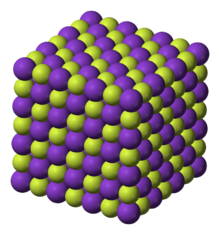Chemistry:Potassium fluoride

| |
| Names | |
|---|---|
| IUPAC name
Potassium fluoride
| |
| Identifiers | |
| |
3D model (JSmol)
|
|
| ChEMBL | |
| ChemSpider | |
| EC Number |
|
PubChem CID
|
|
| RTECS number |
|
| UNII |
|
| |
| |
| Properties | |
| KF | |
| Molar mass | 58.0967 g/mol (anhydrous) 94.1273 g/mol (dihydrate) |
| Appearance | colourless |
| Density | 2.48 g/cm3 |
| Melting point | 858 °C (1,576 °F; 1,131 K) (anhydrous) 41 °C (dihydrate) 19.3 °C (trihydrate) |
| Boiling point | 1,502 °C (2,736 °F; 1,775 K) |
| anhydrous: 92 g/100 mL (18 °C) 102 g/100 mL (25 °C) dihydrate: 349.3 g/100 mL (18 °C) | |
| Solubility | soluble in HF insoluble in alcohol |
| −23.6·10−6 cm3/mol | |
| Structure | |
| cubic | |
| Hazards | |
| GHS pictograms | 
|
| GHS Signal word | Danger |
| H301, H311, H331[1] | |
| P261, P264, P270, P271, P280, P301+310, P302+352, P304+340, P311, P312, P321, P322, P330, P361, P363, P403+233, P405, P501 | |
| NFPA 704 (fire diamond) | |
| Flash point | Non-flammable |
| Lethal dose or concentration (LD, LC): | |
LD50 (median dose)
|
245 mg/kg (oral, rat)[2] |
| Related compounds | |
Other anions
|
Potassium chloride Potassium bromide Potassium iodide |
Other cations
|
Lithium fluoride Sodium fluoride Rubidium fluoride Caesium fluoride Francium fluoride |
Except where otherwise noted, data are given for materials in their standard state (at 25 °C [77 °F], 100 kPa). | |
| Infobox references | |
Potassium fluoride is the chemical compound with the formula KF. After hydrogen fluoride, KF is the primary source of the fluoride ion for applications in manufacturing and in chemistry. It is an alkali halide salt and occurs naturally as the rare mineral carobbiite. Solutions of KF will etch glass due to the formation of soluble fluorosilicates, although HF is more effective.
Preparation
Potassium fluoride is prepared by reacting potassium carbonate with hydrofluoric acid. Evaporation of the solution forms crystals of potassium bifluoride. The bifluoride on heating yields potassium fluoride:
- [math]\ce{ K2CO3 + 4HF -> 2KHF2 + CO2 ^ + H2O }[/math]
- [math]\ce{ KHF2 -> KF + HF ^ }[/math]
Platinum or heat resistant plastic containers are often used for these operations.
Potassium chloride converts to KF upon treatment with hydrogen fluoride. In this way, potassium fluoride is recyclable.[3]
Crystalline properties
KF crystallizes in the cubic NaCl crystal structure. The lattice parameter at room temperature is 0.266 nm.[4]
Applications in organic chemistry
In organic chemistry, KF can be used for the conversion of chlorocarbons into fluorocarbons, via the Finkelstein (alkyl halides)[5] and Halex reactions (aryl chlorides).[3] Such reactions usually employ polar solvents such as dimethyl formamide, ethylene glycol, and dimethyl sulfoxide.[6] More efficient fluorination of aliphatic halides can be achieved with a combination of crown ether and bulky diols in acetonitrile solvent.[7]
Safety considerations
Like other sources of the fluoride ion, F−, KF is poisonous, although lethal doses approach gram levels for humans. It is harmful by inhalation and ingestion. It is highly corrosive, and skin contact may cause severe burns.
References
- ↑ "Potassium Fluoride". https://www.sigmaaldrich.com/catalog/product/aldrich/449148?lang=en®ion=US.
- ↑ Chambers, Michael. "ChemIDplus - 7789-23-3 - NROKBHXJSPEDAR-UHFFFAOYSA-M - Potassium fluoride - Similar structures search, synonyms, formulas, resource links, and other chemical information.". https://chem.nlm.nih.gov/chemidplus/rn/7789-23-3.
- ↑ 3.0 3.1 Siegemund, Günter; Schwertfeger, Werner; Feiring, Andrew; Smart, Bruce; Behr, Fred; Vogel, Herward; McKusick, Blaine (2002). "Ullmann's Encyclopedia of Industrial Chemistry". Ullmann's Encyclopedia of Industrial Chemistry. Weinheim: Wiley-VCH. doi:10.1002/14356007.a11_349..
- ↑ "Potassium fluoride". University College London. https://www.ucl.ac.uk/~ucapahh/research/crystal/kf.htm.
- ↑ Vogel, A. I.; Leicester, J.; Macey, W. A. T. (1956). "n-Hexyl Fluoride". Organic Syntheses 36: 40. doi:10.15227/orgsyn.036.0040.
- ↑ Han, Q.; Li, H-Y. "Potassium Fluoride" in Encyclopedia of Reagents for Organic Synthesis, 2001 John Wiley & Sons,New York. doi:10.1002/047084289X.rp214
- ↑ Silva, Samuel L.; Valle, Marcelo S.; Pliego, Josefredo R. (2020-12-04). "Nucleophilic Fluorination with KF Catalyzed by 18-Crown-6 and Bulky Diols: A Theoretical and Experimental Study". The Journal of Organic Chemistry 85 (23): 15457–15465. doi:10.1021/acs.joc.0c02229. ISSN 0022-3263. PMID 33227195. https://doi.org/10.1021/acs.joc.0c02229.
 |


